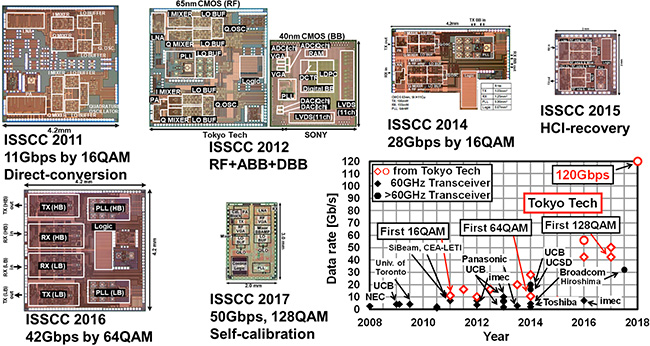The 5
th generation smart phone system will come to use milli-meter wave radio to achieve required high data transmission rates of over 10 Gb/s. As conventional hardware implementations of milli-meter wave radio employ costly compund semiconductor technologies such as GaAs and SiGe, implementation in CMOS integrated circuit technology is desired for low-cost and mass-production capabilities. However the data transmission rate has been quite limited in past CMOS implementations.
For realizing ultra-high transmission data rates of over 10Gb/s, multi-valued modulation schemes such as 16 QAM (Quadrature Amplitude Modulation, 4bits/symbol) and 64 QAM(6 bits/symbol), as well as direct-conversion technologies, not heterodyne schemes, are indispensable, necessitating a low-phase noise quadrature oscillator. However a high-Q LC oscillator required for low-phase noise quadrature oscillator is limited in use for lower than 20 GHz because of the degraded Q (Quality) of capacitors at higher frequency. For example, 16 QAM needs to realize a phase-noise lower than -90dBc/Hz @ 1MHz, while quadrature VCO at 60GHz provided only -75dBc/Hz@1MHz@60GHz, limiting use to only QPSK (Quadrature Phase Shift Keying, 2 bits/symbol).
The recipients developed a break-through basic circuit technology for stabilizing oscillations at 60GHz, by an injection-locking technique to inject low phase noise 20GHz PLL oscillator output to quadrature VCO operating at 60GHz, to achieve -96dBc/Hz@1MHz, a x1/100 improvement over past phase-noise performance. Combining this circuit technique with newly developed wide-band circuit technology such as impedance mathcing schemes by negative-feedback technique, they developed the worldfs first direct-conversion transceiver @60GHz to achieve 11Gb/s data rate by 16 QAM in 2011. This was followed by the worldfs first 4-channel radio transmission @60 GHz including base-band circuitry (2012), a 28Gb/s transmission and the worldfs first 64 QAM (2014), a 42Gb/s transmission by 4-channel 64 QAM (2016), a 50Gb/s transmission (2017), as well as the worlfd first 120Gb/s transmission at 100GHz (2018).
With these achievements proving drastically higher data-rate radio transmission as well as remarkably lower power consumption due to direct conversion techniques, compared with other examples of development, the recipients have led the worldfs R&D activities in cutting-edge CMOS transceivers in milli-meter wave bands to show the potential and feasibility of ultra-high transmission rates in CMOS milli-meter wave radio. As well, they have demonstrated complete small-sized module integration including milli-meter wave radio as well as base-band integrated circuits to show the feasibility of smart phone terminals, for ultra-high data rate transmission by milli-meter wave radio.
With the world-leading R&D of CMOS millimeter-wave radio, the recipients proved that 120Gb/s transmission far exceeding conventional micro-wave transmission is feasible, being recognized by the IEICE paper award and numerous papers presented at notable international conference like ISSCC (IEEE International Solid-State Circuits Conference). With product developments by private companies going on based on these achievements, it is highly expected that these achievements will establish a motive force for the future social infrastructure of ICT.
Profs. Matsuzawa and Okada well deserve the IEICE Achievement Award by virtue of these outstanding achievements.
Die Photos of Developed CMOS Transceivers @60GHz Band and Transmission Rate Trends.
References
- K. Okada, et al., gA 60-GHz 16QAM/8PSK/QPSK/BPSK Direct-Conversion Transceiver for IEEE802.15.3c,h IEEE Journal of Solid-State Circuits, Vol. 46, No. 12, pp. 2988-3004, Dec. 2011.
- K. Okada, et al., gFull Four-Channel 6.3-Gb/s 60-GHz CMOS Transceiver with Low-Power Analog and Digital Baseband Circuitry,h IEEE Journal of Solid-State Circuits, Vol. 48, No. 1, pp.46-65, Jan. 2013.
- R. Wu, et al., "64-QAM 60-GHz CMOS Transceivers for IEEE 802.11ad/ay," IEEE Journal of Solid-State Circuits, Vol. 52, No. 11, pp. 2871-2891, Nov. 2017.
- K. K. Tokgoz, et al., "A 120Gb/s 16QAM CMOS Millimeter-Wave Wireless Transceiver," IEEE International Solid-State Circuits Conference (ISSCC), San Francisco, CA, pp. 168-169, Feb. 2018.




